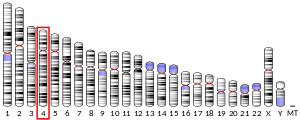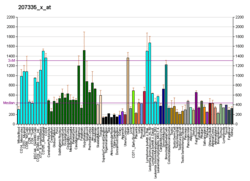ATP5I
ATP synthase subunit e, mitochondrial is an enzyme that in humans is encoded by the ATP5ME gene.[3][4]
| ATP synthase E chain | |||||||||
|---|---|---|---|---|---|---|---|---|---|
| Identifiers | |||||||||
| Symbol | ATP-synt_E | ||||||||
| Pfam | PF05680 | ||||||||
| InterPro | IPR008386 | ||||||||
| SCOPe | 1e79 / SUPFAM | ||||||||
| |||||||||
Mitochondrial ATP synthase catalyzes ATP synthesis, utilizing an electrochemical gradient of protons across the inner membrane during oxidative phosphorylation. It is composed of two linked multi-subunit complexes: the soluble catalytic core, F1, and the membrane-spanning component, Fo, which comprises the proton channel. The F1 complex consists of 5 different subunits (alpha, beta, gamma, delta, and epsilon) assembled in a ratio of 3 alpha, 3 beta, and a single representative of the other 3. The Fo seems to have nine subunits (a, b, c, d, e, f, g, F6 and 8). This gene encodes the e subunit of the Fo complex.[4]
In yeast, the FO complex E subunit appears to play an important role in supporting F-ATPase dimerisation. This subunit is anchored to the inner mitochondrial membrane via its N-terminal region, which is involved in stabilising subunits G and K of the FO complex. The C-terminal region of subunit E is hydrophilic, protruding into the intermembrane space where it can also help stabilise the F-ATPase dimer complex.[5]
References
- GRCh38: Ensembl release 89: ENSG00000169020 - Ensembl, May 2017
- "Human PubMed Reference:". National Center for Biotechnology Information, U.S. National Library of Medicine.
- Swartz DA, Park EI, Visek WJ, Kaput J (Oct 1996). "The e subunit gene of murine F1F0-ATP synthase. Genomic sequence, chromosomal mapping, and diet regulation". J Biol Chem. 271 (34): 20942–8. doi:10.1074/jbc.271.34.20942. PMID 8702853.
- "Entrez Gene: ATP5ME ATP synthase membrane subunit e".
- Everard-Gigot V, Dunn CD, Dolan BM, Brunner S, Jensen RE, Stuart RA (February 2005). "Functional analysis of subunit e of the F1Fo-ATP synthase of the yeast Saccharomyces cerevisiae: importance of the N-terminal membrane anchor region". Eukaryotic Cell. 4 (2): 346–55. doi:10.1128/EC.4.2.346-355.2005. PMC 549337. PMID 15701797.
External links
- Human ATP5ME genome location and ATP5ME gene details page in the UCSC Genome Browser.
Further reading
- Kinosita K, Yasuda R, Noji H (2003). "F1-ATPase: a highly efficient rotary ATP machine". Essays Biochem. 35: 3–18. doi:10.1042/bse0350003. PMID 12471886.
- Oster G, Wang H (2003). "Rotary protein motors". Trends Cell Biol. 13 (3): 114–21. doi:10.1016/S0962-8924(03)00004-7. PMID 12628343.
- Leyva JA, Bianchet MA, Amzel LM (2003). "Understanding ATP synthesis: structure and mechanism of the F1-ATPase (Review)". Mol. Membr. Biol. 20 (1): 27–33. doi:10.1080/0968768031000066532. PMID 12745923.
- Elston T, Wang H, Oster G (1998). "Energy transduction in ATP synthase". Nature. 391 (6666): 510–3. doi:10.1038/35185. PMID 9461222.
- Wang H, Oster G (1998). "Energy transduction in the F1 motor of ATP synthase". Nature. 396 (6708): 279–82. doi:10.1038/24409. PMID 9834036.
- Gubin AN, Njoroge JM, Bouffard GG, Miller JL (1999). "Gene expression in proliferating human erythroid cells" (PDF). Genomics. 59 (2): 168–77. doi:10.1006/geno.1999.5855. PMID 10409428.
- Ying H, Yu Y, Xu Y (2002). "Antisense of ATP synthase subunit e inhibits the growth of human hepatocellular carcinoma cells". Oncol. Res. 12 (11–12): 485–90. doi:10.3727/096504001108747495. PMID 11939412.
- Strausberg RL, Feingold EA, Grouse LH, et al. (2003). "Generation and initial analysis of more than 15,000 full-length human and mouse cDNA sequences". Proc. Natl. Acad. Sci. U.S.A. 99 (26): 16899–903. doi:10.1073/pnas.242603899. PMC 139241. PMID 12477932.
- Cross RL (2004). "Molecular motors: turning the ATP motor". Nature. 427 (6973): 407–8. doi:10.1038/427407b. PMID 14749816.
- Gerhard DS, Wagner L, Feingold EA, et al. (2004). "The status, quality, and expansion of the NIH full-length cDNA project: the Mammalian Gene Collection (MGC)". Genome Res. 14 (10B): 2121–7. doi:10.1101/gr.2596504. PMC 528928. PMID 15489334.
- Papathanassiu AE, MacDonald NJ, Bencsura A, Vu HA (2006). "F1F0-ATP synthase functions as a co-chaperone of Hsp90-substrate protein complexes". Biochem. Biophys. Res. Commun. 345 (1): 419–29. doi:10.1016/j.bbrc.2006.04.104. PMID 16682002.



